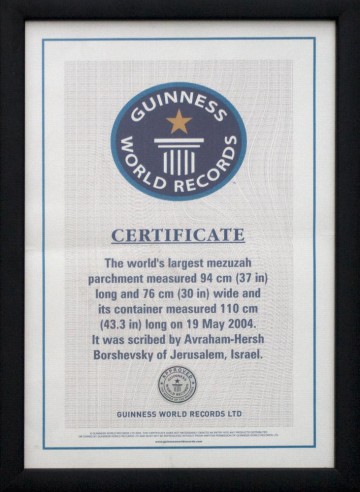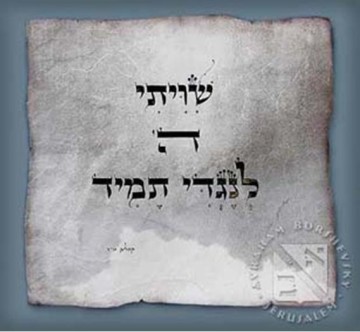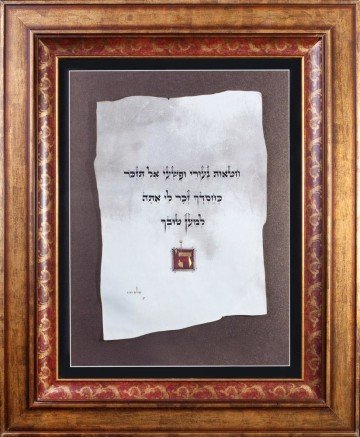Avraham Borshevsky

Avraham Borshevsky
Jerusalem, Israel
Calligrapher-artist, Judaic sacred texts expert
Sacred Hebrew Calligraphy
1. Peculiarities of the Hebrew Alphabet
Writing and calligraphy play a crucial role in a three-thousand long Jewish history. The Hebrew Alphabet* is called “alephbet” after the first two letters of the Hebrew alphabet “aleph” and “bet”. The symbols and order of the Hebrew alphabet remain unchangeable, that is why the letters have always been used to indicate figures as well. The full alphabet consists of 27 consonants: 22 basic and 5 additional.

Each letter consists of simple module elements:

According to the Kabbalah**, sacred calligraphy is the revelation of Mystical insight of the Prophet Moses encoded in 22 scheme letters which in their turn express the interrelation of the 10 highest levels.

Each letter consists of two interpenetrating forms: the letter itself and the surrounding background.

2. Area of application

Sacred texts of Judaism include canonic texts of all 24 Tanakh books (full Jewish Bible) and texts which tell the oral Legendary.
Sacred calligraphy serves the execution of texts necessary for following the rules and custom:
- Sefer Torah
- Tefillin
- Mezuzah
- Five scrolls: The Song of Songs, Ruth, Lamentations of Jeremiah, Ecclesiastes and Book of Esther
- Prophets’ books which are read out in synagogues
- Execution of Sefer Torah
3. Traditional cannons of sacred texts execution
Various sacred Jewish texts are written in accordance with certain rules. Let us consider some rules and standards by the example of Mezuzah writing.
Letter forms
The strict cannons determine the final form of each of 27 letters. The rules of writing are fixed in professional reference books in Hebrew. The standards of letter writing are constant and do not depend on the size of the font.
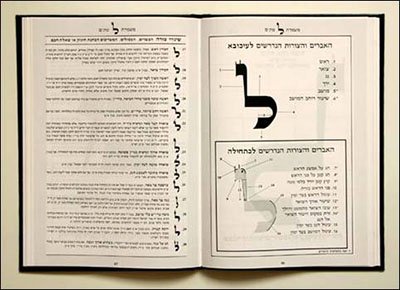
Below are given compulsory standards of writing of the letter “tsadi” which consists of letters “yud” and “nun”:
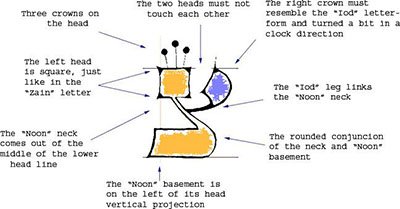
Technique of text inscription
A kosher letter is written in ink only: not engraving, application, nor printing.
Letter integrity
Each letter has to be solid and have no splits. A split seen with the naked eye makes the whole letter and text non-kosher.
ЦIntegrity of the background surrounding a letter
Letters mustn’t touch themselves, mustn’t touch one another or the parchment edge. Contact between letters seen with the naked eye makes the whole letter and text non-kosher.
Order of letters
The letters are written from right to left just like the text is read. A missed letter cannot be written afterwards.
Correction of mistakes
There are some mistakes which are allowed to be corrected and some other mistakes which are not. A scribe must study the rules of correction.
4. Materials and instruments
Parchment
Only specially dressed skins of kosher animals (calf, goat) can be used as writing material. Papyrus or paper are not used.

Ink
Black varnish ink is used for writing. At present time it is made of soot, gall, wood resin and blue stone. The written letters shine like wood resin. Varnish ink is not water-proof.
Quill
Since times immemorial scribes had used pens of reed. In the medieval times kosher bird quills (turkey, goose) were widely spread. The advantage of bird quill is that a scribe can write the broadest and tiniest lines with one and the same quill. Metal quills are not used.
 Quill nibbing
Quill nibbing
Lining out
Except for tefillin scrolls preliminary lining of parchment is a compulsory procedure for writing a sacred text and is done manually. The letters are written under perforated lines.
5. Writing technique
The elements of letters are written from right to left along the nap of the parchment. Sacred texts are not written from memory, but copied. When writing a scribe pronounces out loud every sentence, and then puts it down.

6. System of manuscript control
Traditions and usage of advanced technologies
After a manuscript is ready it is thoroughly checked:
- Orthographic control of all words,
- Graphic expertise of each letter.

In addition to this control nowadays they use computer copy testing which has already proved its efficiency.
Notes:
*Alphabet – a foreign word “alphabet” is derived from the names of the first two letters of Greek alphabet “alpha” and “beta” which are identical to Aramaic names of letters of Hebrew alphabet: “aleph” and “bet”. Among 33 letters of the modern Cyrillic Russian alphabet 5 originate from the Hebrew language: Ж. Ц. Ч. Ш. Щ.
**Kabbalah – Hebrew: “received Legendary”, a mystical part of the oral Tradition.
Author works
The World Famous Mezuzah. Deuteronomy 6:4-9, 11:13-21
Calfskin vellum 76x94 cm cased in a 110 cm container. Torah scroll black ink, Turkey quill, black lacquer ink. 2004Мezuzah official photo
The interior of the world’s largest Kosher Mezuzah is written by A. Borschevsky and registered in the Guinness World Records book of in 2004.Author reprint, 38.5x29 cm, 2004
The World Famous Mezuzah Parchment. Unfolded. Author reprint.
Facsimile edition 1:1The original: Calfskin vellum, turkey quill, black lacquer ink, 76x94 cm, 2004
"When thou lightest the lamps". Numbers 8: 1-14
Calfskin vellum, Torah scroll black ink, yellow gold leaf 24K, Indian red сalligraphy ink, brush, turkey quill, 19.5x46,5 cm, 2009"And it happened at midnight…". Exodus 12, 29-51
Calfskin vellum, Torah scroll black ink, platinum-gold leaf, white gold leaf, egg tempera, brush, turkey quill, 22.5*57 cm, 2009"Remember not the sins of my youth...". Psalms 25:7
Calfskin vellum, Torah scroll black ink, gold leaf 24K, egg tempera, brush, turkey quill, 33x44 cm, 2008The Priestly Blessing (original)
Red eastern parchment, Torah scroll ink, turkey quill, 24x49 cm, 2008.Mezuzah and a pen
Silver case, parchment – calves-skin, turkey feather, black Torah scroll ink, 24x4 см, 2008Calligraphy — the written beauty of feelings.



